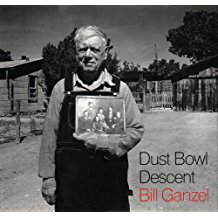Dust Bowl Descent, Bill Ganzel, 1984
This is a fascinating and touching book in which Ganzel honors the photographers of the Farm Security Administration (Dorothea Lange, Arthur Rothstein, John Vachon, Russell Lee, and Marion Post Wolcott) who in the 1930’s were sent into the Dust Bowl to document the disastrous effect on people’s lives, primarily in Oklahoma, the Dakotas, and Nebraska as the Depression and the drought destroyed a way of life. Returning to those towns 40 years later, Ganzel found many of the same people and many of the same sites, and ‘rephotographed’ them, establishing a pictorial record of aging, change, and tenacity. The dominant theme is the strength of character that people show when they are beaten down and nearly defeated. Two photographic pairs remain in my mind. One is the cover photo showing George Hutton, Jr. of Pie Town, NM in 1980 holding a photograph of him and his brother, two sisters, and parents from Pie Town in 1940. George remained after 40 years running his machine shop which he had started on his family’s farm in 1940. He stated “Otherwise, life here has been on, you might say, a regular routine living. No outstanding incidents that’s ever happened.” The other pair of photographs is the famous family portrait from 1936 by Dorothea Lange entitled Migrant Mother showing Florence Thompson holding her infant daughter while two older girls shyly hide behind her. Thompson and the 3 girls are shown in 1979 in Modesto, CA where they now live. As said by Ruby Sprague, the youngest, “She worked hard, brought us up and kept us together. We all have good jobs and we all own our own homes. And none of us have ever been in trouble.” That would serve as a good summary of these intimate portraits over time and a fitting epitaph for the strong Great Plains people so beset by Depression and Dust in the 1930’s.



